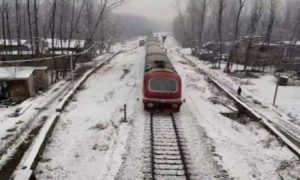These stations are being developed to meet international standards in functionality, operation, and sustainability.
As part of the ambitious Mumbai-Ahmedabad High-Speed Rail (MAHSR) project, stations along the corridor will feature state-of-the-art facilities and design features aimed at providing a seamless travel experience. These stations are being developed to meet international standards in functionality, operation, and sustainability.
Read More: Delhi Residents Continue To Suffer As Air Quality Remains ‘Very Poor’ As AQI Hits 332
World-Class Amenities and Accessibility Features
The design of the stations will prioritize passenger comfort and accessibility. The stations will boast soothing colors, ample seating arrangements in waiting areas, lounges, kiosks, and clear signages for easy navigation. Efforts have been made to ensure that these stations are located within the city limits and are well-connected to other modes of transport, including local railways, city buses, Metro lines, and parking facilities.
High-speed train travel requires longer durations, so special attention has been paid to providing high-quality restrooms. Each station will also feature nurseries for children and lockers for storing baggage, catering to passengers who may take day trips to cities. Business lounges will be available for first-class passengers, providing a comfortable space to relax.
In keeping with inclusivity, the stations will cater to differently-abled passengers with wheelchair-friendly designs, lowered ticketing counters with Braille instructions, braille buttons in elevators, dedicated washrooms, and tiles for guidance.
Read More: ED Raids Raj Kundra’s Mumbai Residence In Pornographic Content Case
Station Area Development: Promoting Economic Growth
The MAHSR stations are being envisioned as destinations in their own right, not just transit hubs. The areas surrounding these stations will be developed as centers for economic growth, promoting existing industries and attracting new ones. This initiative, known as Transit-Oriented Development (TOD), aims to elevate the standard of living for local communities along the corridor.
To support this development, NHSRCL is collaborating with stakeholders, including state governments, local authorities, and international experts. Notably, Japanese experts are assisting in the development of model stations in Gujarat and Maharashtra, including Virar and Thane in Maharashtra and Sabarmati and Surat in Gujarat.
Green Stations: Sustainable Design for the Future
Sustainability is a key focus in the design of the high-speed rail stations. All the stations will be developed as ‘green’ buildings, featuring energy-efficient lighting, water-efficient fixtures, and eco-friendly construction materials. Passive energy-saving measures and active ecological energy systems will help reduce energy consumption.
Integrated solar panels will be installed on station roofs wherever feasible, contributing to the stations’ energy needs and minimizing reliance on external sources. Large windows will allow for natural light and views, reducing the need for artificial lighting and improving ventilation.
Rainwater harvesting systems and water rejuvenation pits will be incorporated into the design of all buildings, supporting sustainable water management practices.





































